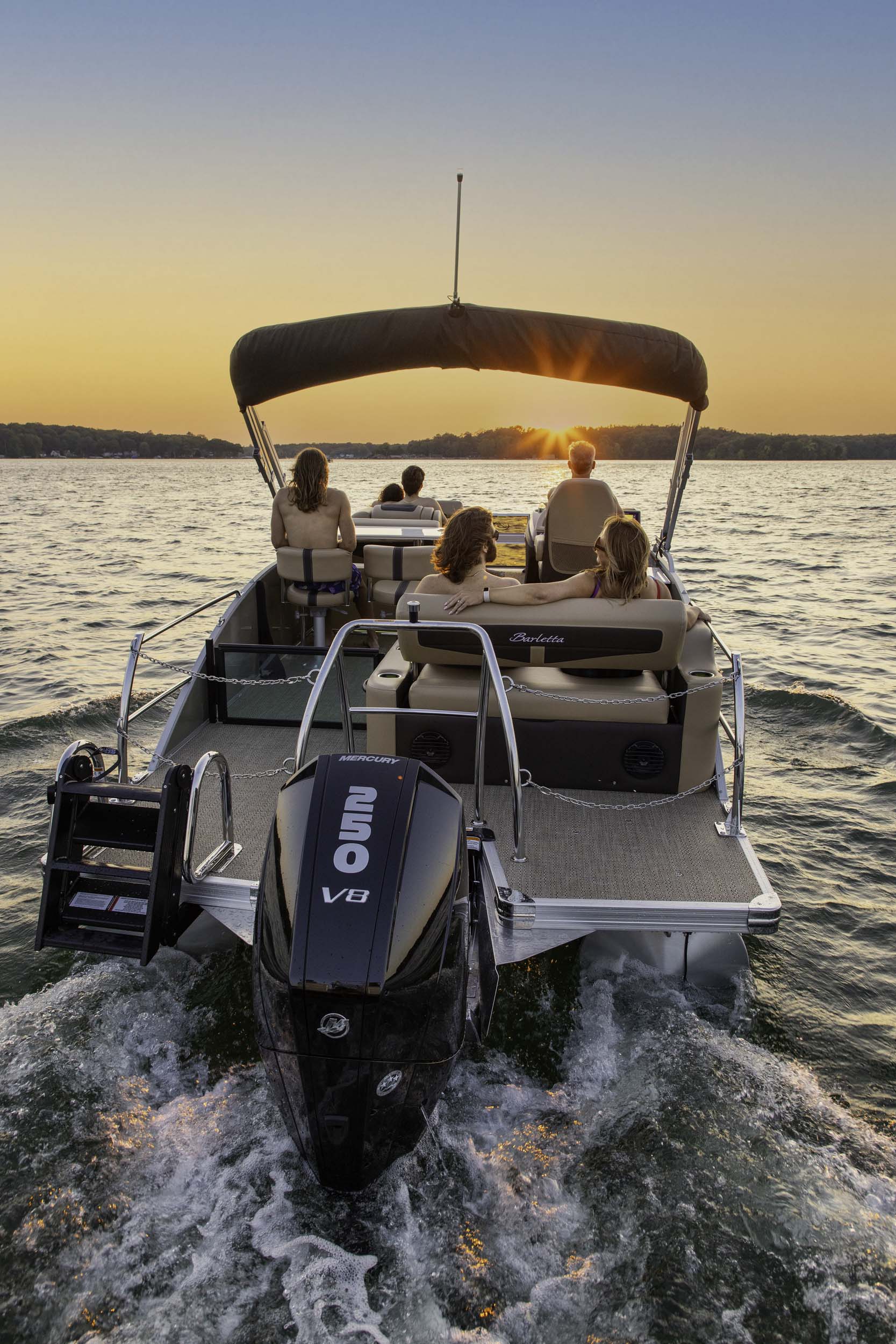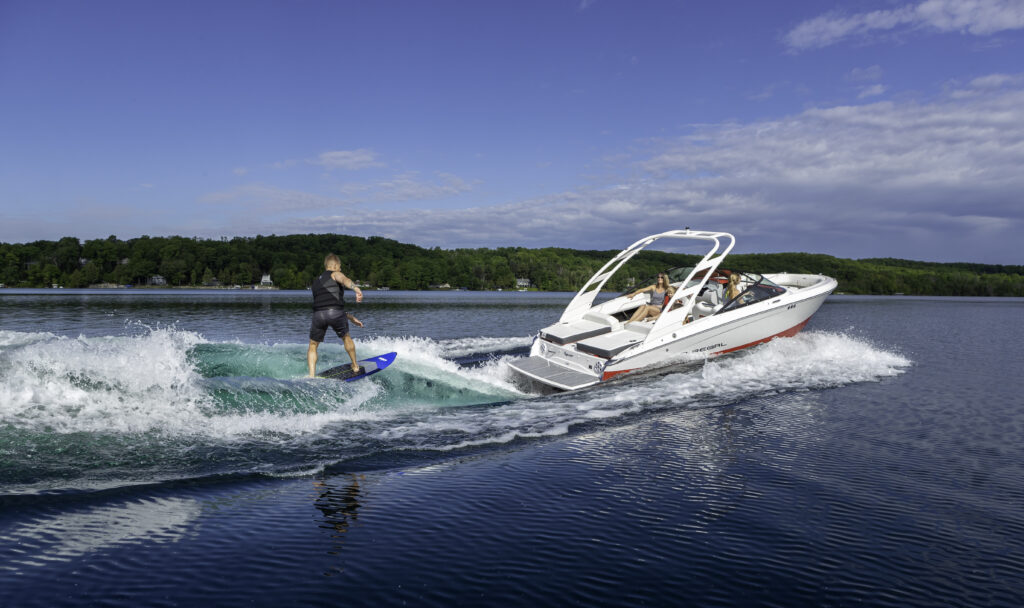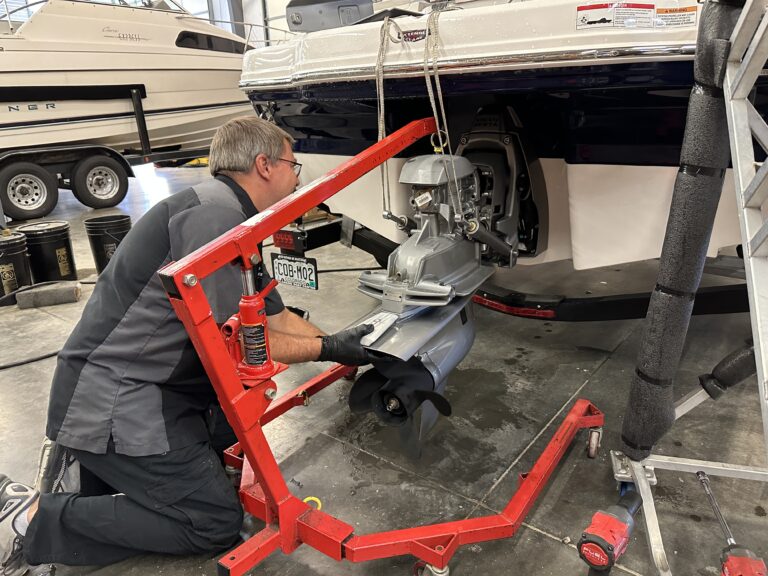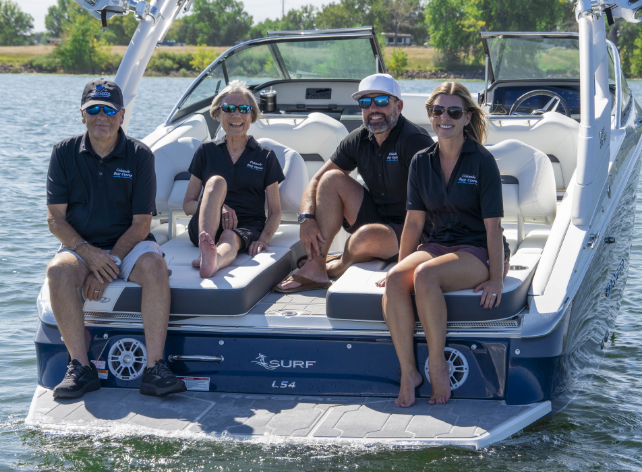
That would be Inboards and Outboards. And let’s not forget (we won’t) Sterndrives and even Jet Drives.
This might sound elemental (because it is) but every boat buyer–new or used–should understand the power plant that drives the boat, how it works, pros and cons of each type, and things (like cost of maintenance) that should also be considered.
Originally, of course, boats were powered by oar and sail and remained so until 1787 when a man named John Fitch successfully demonstrated a boat powered by an onboard steam engine. Not long after, Robert Fulton invented the steam-powered paddle boats which became commercially successful up and down the Mississippi River.
But the first boats powered by petrol-driven engines were developed in 1886 on the Neckar River in Germany by two automobile pioneers: Gottlieb Daimler and Wilhelm Maybach. Quickly, new marine engine designs were developed in Great Britain, by William Dent Priestman, J.D. Roots and Frederick William Lanchester. American ingenuity followed in the person of John L. Hacker, whose Hacker Boat Co. built the Kitty Hawk in 1911, a step hydroplane that achieved a top speed of an unheard of 50 mph.
We’ll skip the ensuing 100-plus years of marine engine design and improvements (you’re welcome) and arrive at where we are today: boat buyers can choose from outboard engines, inboard engines, sterndrive engines and jet drive engines. Let’s take a look at each one.
Outboard engines
Outboard engines are mounted on the rear transom of the boat, outside of the boat’s hull, which is why they’re called outboards. Outboards are used to both power and steer the boat–to steer, the engine is physically moved in different directions. In smaller boats, the engine is moved with a tiller handle. In larger boats, the engine is connected to a steering wheel at the boat’s helm, and the wheel moves the engine direction from side to side.

Outboards come in many different sizes, usually ranked by horsepower output. Typically for recreational boats, outboards come in 90 HP up to 300 HP, although there are outboards that deliver up to 600 HP or power. Typically, these are used to power larger cruisers, often linked two, three and four abreast, which can deliver very impressive results in speed.
And while the typical pleasure boat used for fishing, skiing, cruising (especially on pontoons) and just motoring around on Colorado’s lakes does not need the monster power of a 600 HP, Mercury V-12, it’s good to know that the choice is there.
Pros
- That flexibility in customizing your power plant is one of the main Pros of outboards.
- Outboards typically weigh less and have a more efficient design, so most owners will find fuel economy is better.
- Maintenance is often less expensive as well. All marine engines need regular upkeep and service, but, for instance, in winter, outboards are self-draining, so most halfway-proficient owners can quickly learn how to do it.
- Because an outboard is attached outside the hull, there is more room inside the boat for gear, extra passengers, storage space and more.
- Outboards are quieter, more efficient and get new features almost every year, so it’s relatively easy for a boat owner to upgrade to gain the advantage of all the new bells and whistles. (Relatively easy means you just have to produce a credit card!)
- The outboards can be lifted (or trimmed) up out of the water, allowing the boat to be beached for picnics and exploration ashore.
Cons
- Whatever metric you use, outboard engines are usually a bit more expensive than the other choices. Ease of maintenance helps offset the up-front cost.
- Because of their location off the rear transom, outboard engines often get in the way of swim platforms. Boat designers are responding by installing platforms off to the side, or in other ways to get around the rear-mounting.
- Outboards have a constraint on the size of their propellers. Most have a diameter maximum of 16 inches. Props with larger diameters can deliver more speed and oomph.
Inboard engines
Inboard engines–mounted inside the hull–are the classic original marine propulsion system. The mounted gasoline or diesel engine delivers power to the propeller through a drive shaft that passes through the bottom rear of the hull, and a separate rudder steers the boat through the steering wheel.
Inboard engines are popular with those into tow sports. This type of engine delivers a lot of torque and with the props well under the boat skiers and boarders can be quickly pulled up on plane and are held well against the strain of the rope. An inboard can provide relatively little turbulence behind the boat, and boat designers can play with the hull design to produce the kinds of waves that surfers love to ride.
Pros
- The props are usually well under the boat, which leaves plenty of room for swimming platforms off the stern.
Cons
- Servicing an inboard engine can be tricky and usually requires a trained service technician. Access to the working parts of the engine is through a hatch in the deck and can be quite confined–think lots of skinned knuckles and hyper-compound oaths, audible or not.
- Inboards can be a little harder to handle, especially in docking maneuvers. But most owners quickly learn the tricks of getting their boat into and out of tight places.
- If an inboard engine goes ka-put, the cost of replacing the whole powerplant is much more expensive than buying a new outboard.
Sterndrive engines
Sterndrive engines are often called “inboard/outboard” because they combine the features of both engines. Most utilize automobile-type engines mounted inside the hull to power the boat. But like an outboard, there is a drive unit to steer the boat: when you turn the steering wheel, the drive unit turns to determine the direction the boat goes.

Pros
- The Sterndrive combines the torque of an inboard with the steerable and trimmable capabilities of an outboard, leading to easier, more confident steering at low speeds.
- The trimmable drive improves performance and economy and a fully trimmed or lifted engine allows for beaching.
- Gas sterndrive engines range from 200-430 HP.
- Some of the newer models have forward-facing props for use in high performance wake surfing.
Cons
- Sterndrives performance can trail that of outboards. A 250 HP sterndrive will match the performance of a 200 HP outboard because the outboard weighs less and the weight is more efficiently located behind, rather than inside the boat. On the other hand, a sterndrive is typically 2-4% less expensive than an outboard.
- Maintenance costs are the same as inboards.
- Sterndrives once had a reputation for being prone to corrosion issues, especially in salt water boats. But all sterndrives come with sacrificial anodes to guard against galvanic corrosion. Keeping those anodes fresh is a part of the required maintenance on any sterndrive.
Jet drive engines
A jet drive boat is powered and steered by a stream of water. Water enters in through an intake on the bottom of the boat and is accelerated through the jet drive unit at the transom, thrusting the boat forward.
Steering is accomplished by changing the direction of the jet unit. Because direction depends on the position and speed of the water jet, some steering control is lost at low speeds.
The engine in a jet drive turns an impeller which sucks the water in and propels it out in a high-powered stream. There is no propeller, which makes jet drive boats good for use in shallow-water situations.
Pros
- Most jet drive engines are compact four-cylinder engines that take up less space.
- A diverter is used for reverse-thrust.
- They are lighter than sterndrive engines.
Cons
- They can be a little more expensive.
- The pump intake can get clogged with weeds and other detritus.
- The boat’s running angle generally cannot be adjusted for extra passengers or speed conditions.
- Not very fuel efficient, and sometimes quite loud.
- Regular maintenance is required for proper performance.
Forward Drive engines
Volvo Penta engineers began playing with forward-drive propulsion systems about ten years ago, taking a fuel-economy concept used in larger cruisers and commercial vessels and adapting it for use in sport boating. The basic concept is an inboard propulsion system that utilizes twin counter-rotating props that pull the boat through the water, rather than push it.

It’s called a forward drive engine because the props are located forward of the drive housing rather than behind as in all other marine engines. This type of engine provides an unusual boost to the boat, which means it gets up on plane faster and has increased maneuverability and stability in operation.
And – here’s the big selling point – a forward drive engine can be trimmed to produce great waves in the boat’s wake. The fastest growing category of boats these days is wake sports–wake surfers, wake boarders, water skiers and tow riders–so interest in forward drive engines is high. With the props located about 26 inches forward of the transom, there are no worries about accidents for skiers or swimmers on a forward-drive boat.
Pros
- Because the exhaust is expelled out of the back of the drive housing (underwater) the props can be larger and more efficient, resulting in improved speed, acceleration, maneuverability and fuel economy.
- Units react faster to steering wheel or joystick, with tighter turns and better control
- Unlike many inboards, forward drive engines provide great control when docking or operating at low speeds.
- The dual props provide less torque steer than single-prop boats, resulting in straighter tracking at cruising speeds. The dual props also provide symmetrically sized wakes on both port and starboard, making life easier for surfers and boarders.
Cons
- The props and drive housing beneath the boat are vulnerable to striking objects. There is a breakaway coupling between the vertical drive shafts to reduce damage if the props should hit a heavy object.
- Creating a wake boat requires more than just forward-facing props. You might need ballast tanks, wake-enhancing trim tabs, and a GPS-based speed control system to get optimal results.
That is the basic lesson on marine engines. There are, of course, tons of differences among and between various models and brands, used and new, and results always vary with conditions and how you drive your boat.
For the full details on an engine you’re considering, stop in to Colorado Boat Center and talk with one of our experienced sales associates. Or with our service technicians, all of whom are certified in Mercury, Yamaha and Volvo Penta marine engines. They know even more of the Ins and Outs and can answer all of your questions.




